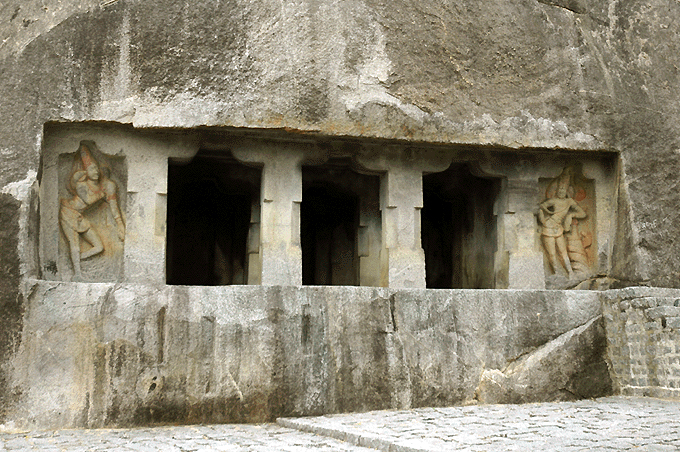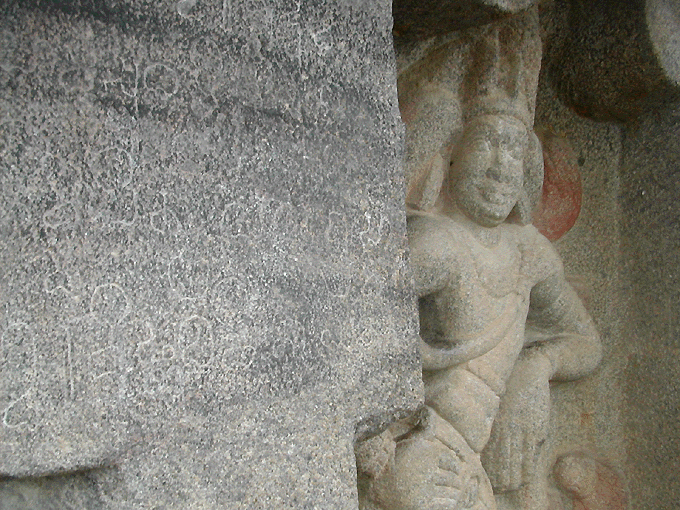
|
|
|
|
In this inscription, Mahendra proudly proclaims himself to be 'Vichitra-chitta', which translates to ‘curious-minded’. In fact, this is but one of the more than 130 such titles that Mahendra assigned to himself in various inscriptions, describing his own excellent qualities and accomplishments. Some of these are quite surprising designations for a king, such as Mattavilasah (‘drunken sport’), Virasah (‘tasteless’) and Kalahapriya (‘one who enjoys squabble’. It seems that Mahendra was either a humble man, or a bit of a rascal. As for the claim that the rock-cut temple at Mandagappattu was the first such edifice to be built without brick, timber, metal and mortar, this is not an accurate statement. It may be that Mahendra meant "the first in Tamil Nadu", or perhaps he was simply unaware that half a century before, the famed Chalukyas were building rock-cut caves in Badami. The Krishna basin caves also preceded his work, as did the Pillaiyarpatti caves. While the Chalukyas deliberately chose finely-grained sandstone for their cave temples, Mahendra set the stage for excavation in the Tamil country of very hard rock, mostly granite. For this reason his cave temples were simpler in design, and smaller. The Laksitayatana (Laksita-ayatana) Trimurti cave temple, built in the early 7th century, sits on a 100-foot high hill, facing north, beside a theertham. That it was dedicated to the deities is evident by the term 'ayatanam', while 'laksita' was yet another name for Mahendra.
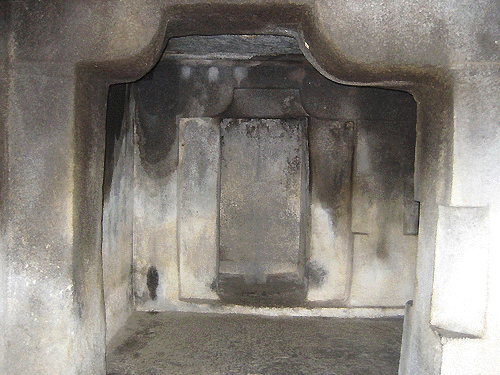
Deity shrine in Mandagappattu cave temple The temple consists of three cells, or garbhagrihas, that at one time enshrined deity images of the Trimurti personalities. The shrines are empty today, as they would have been originally, because the embodied deities were installed only in the form of figural representations sculpted in bas relief and painted on the back wall of each cave shrine. Remnants of these paintings are still extant at Mandagappattu. The right sanctum shrine houses Lord Brahma, with Shiva in the center cell, and Visnu on the right. Some Saivite scholars consider this image of Lord Brahma to be Brahmasasta, a form combining Brahma and Skanda. As our previous segments have indicated, there was a trend, particularly in South India, to impose attributes of Shiva onto Lord Brahma, as direct worship of Brahmadeva waned over time.
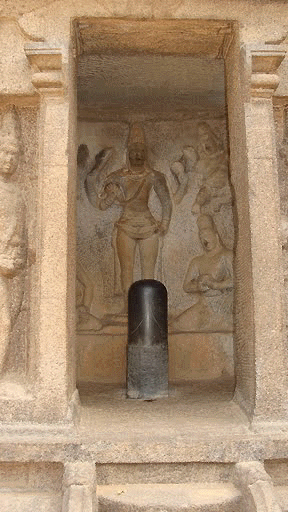
Lord Brahma, Trimurti cave temple at Mahabalipuram Steps at the end of a wide stone courtyard lead to an uncovered porch, which sits before a simple rectangular mandapa with four large, equidistant pillars. The pillars have an octagonal central section, square base and capital, with curved corbels. Inside the sanctum, another row of similar pillars divides the sanctum into three aisles, which lead to the three Trimurti shrines. The three deity niches are deeply carved into the rear cave wall. On the temple façade, two beautiful dvarpalakas are carved in bas relief. These are thought to have been later additions. They are wearing tall headgear and stand in dvibhanga pose, leaning on clubs, one entwined by a naga. As the inscription by Vichitrachiita Mahendra at Mandagappattu indicates, prior to the excavation of this cave-temple, other temples in South India were built from brick, timber, metal and mortar. So while these rough-hewn cave temples might appear to be the rudimentary precursors to more refined examples of temple architecture, they were obviously not the earliest temples built in the area. Other elaborate temple structures were built long before Mahendra began chiseling out his cave temples. Being made of perishable materials, however, nearly all of these ancient temples fell into ruin long ago.
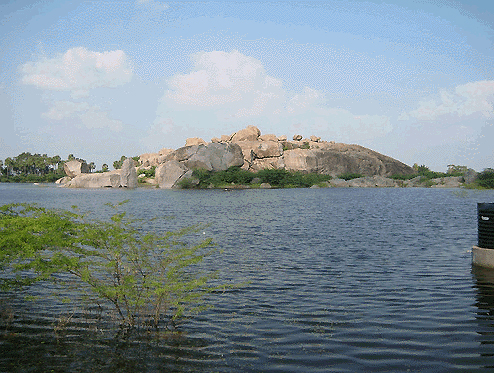
Lake beside Mandagappattu cave temple Those interested in Dravidian architecture have been very intent on documenting this particular era, which represents a bridge in temple building styles. One historian believed that a likely place to find such ruins was Kanchipuram, first because it was the central capital of Mahendra's kingdom, and secondly, because it lies on a plain where there are very few rocks. It stood to reason that some of the temples Mahendra referred to in his inscription, being built of brick, timber, metal and mortar, were to be found in Kanchipuram. That historian was proven right. It seems fitting, therefore, that Kanchipuram is our final destination in the state of Tamil Nadu. With one last stop before Kanchipuram, we'll visit a cluster of very interesting temples there in which Lord Brahma is glorified.
Some pictures courtesy of Raju's Temple Visits, Flikr.
| |
